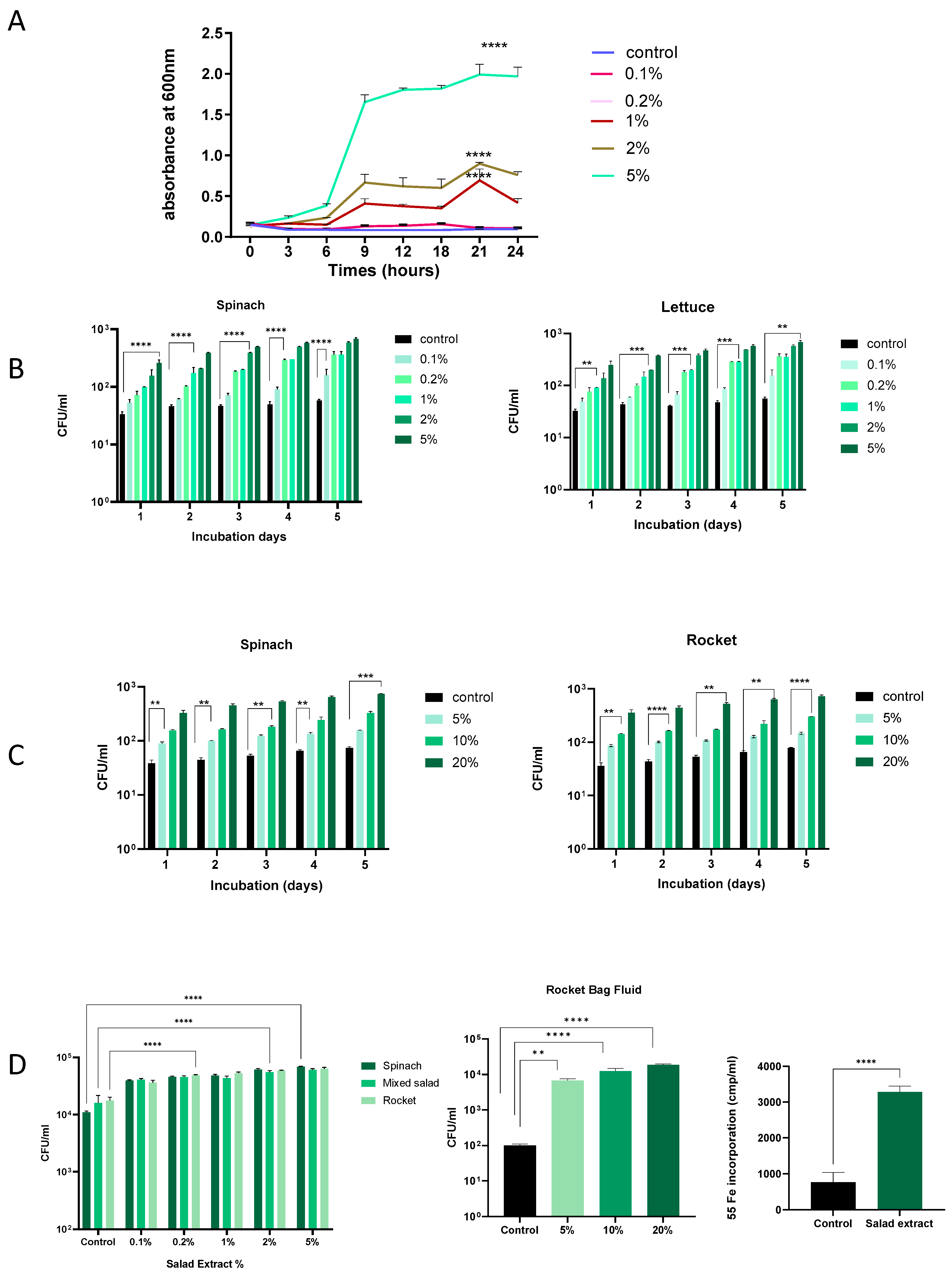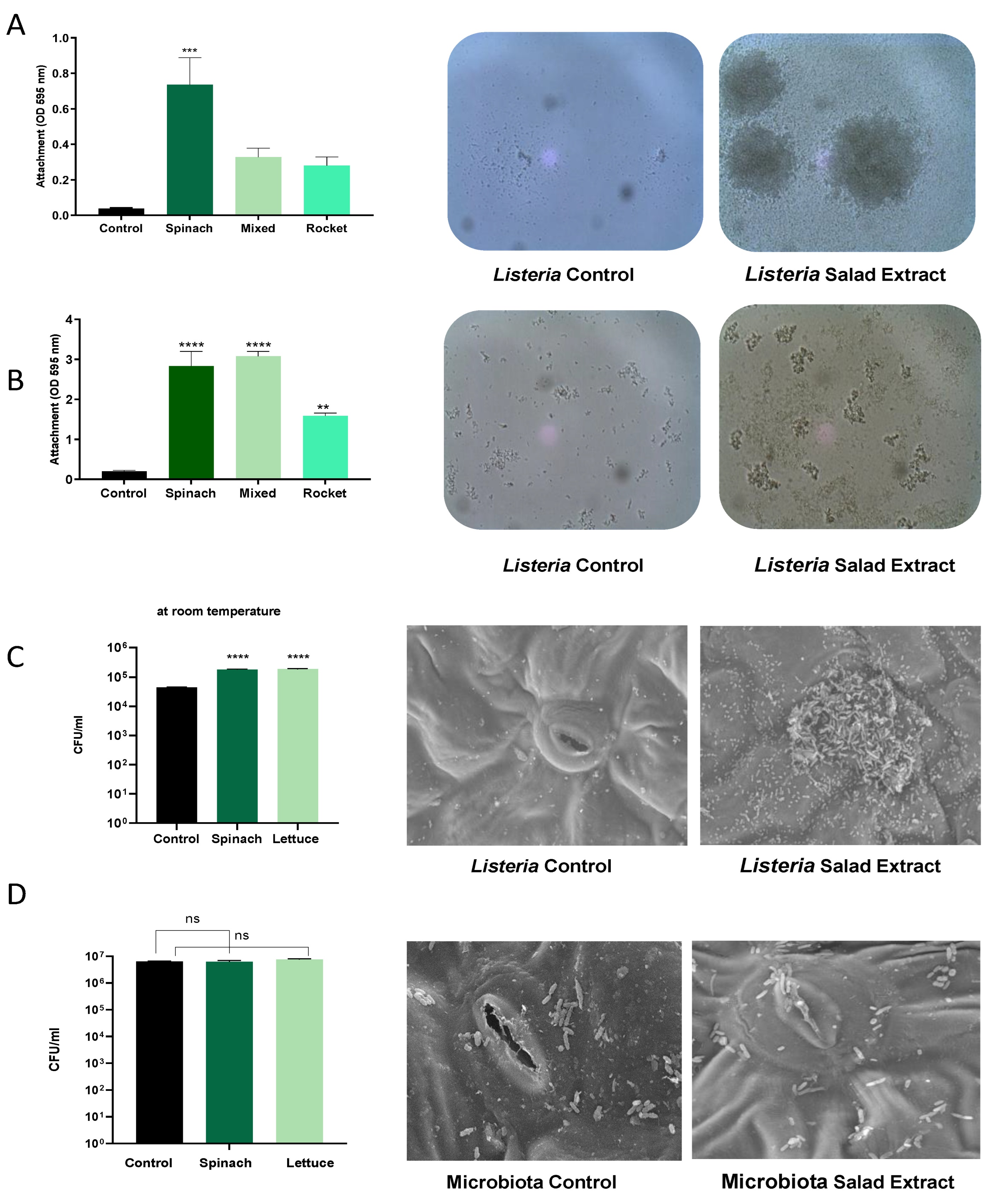The Impact of Compounds Released from Damaged Salad Leaves on the Growth and Virulence of Listeria monocytogenes
Abstract
1. Introduction
2. Materials and Methods
2.1. Bacterial Strains, Culture Media, and Growth Profiling
2.2. Salad Leaf Extract Preparation
2.3. L. monocytogenes EGD Biofilm Quantification
2.4. L. monocytogenes EGD Virulence Studies
2.5. Chlorine Inactivation by Salad Leaf Extracts
2.6. The Microbial Content of Bagged Salads
3. Results
3.1. Listeria Growth Is Increased by Salad Leaf Fluids
3.2. Listeria Biofilm Formation and Salad Leaf Colonization Is Enhanced by Salad Extract Exposure
3.3. Salad Bag Microbiota Studies
3.4. Listeria virulence Is Enhanced by Salad Extract Exposure
4. Discussion
Author Contributions
Funding
Data Availability Statement
Acknowledgments
Conflicts of Interest
References
- Boeing, H.; Bechthold, A.; Bub, A.; Ellinger, S.; Haller, D.; Kroke, A.; Leschik-bonnet, E.; Müller, M.J.; Oberritter, H.; Schulze, M. Critical review: Vegetables and fruit in the prevention of chronic diseases. Eur. J. Nutr. 2012, 51, 637–663. [Google Scholar] [CrossRef] [PubMed]
- Olaimat, A.N.; Holley, R.A. Factors influencing the microbial safety of fresh produce: A review. Food Microbiol 2012, 32, 1–19. [Google Scholar] [CrossRef] [PubMed]
- Koukkidis, G.; Freestone, P. Salmonella Contamination of Fresh Salad Produce: Prevalence, Impact and Reduction Strategies. J. Hortic. Sci. Crop Res. 2018, 1, 1–8. [Google Scholar]
- Mercanoglu, T.B.; Halkman, A.K. Do leafy green vegetables and their ready-to-eat [RTE] salads carry a risk of foodborne pathogens? Anaerobe 2011, 17, 286–287. [Google Scholar] [CrossRef]
- Harris, L.; Farber, J.; Beuchat, L.; Parish, M.; Suslow, T.; Garrett, E.; Busta, F. Outbreaks associated with fresh produce: Incidence, growth, and survival of pathogens in fresh and fresh-cut produce. Compr. Rev. Food Sci. Food Saf. 2003, 2, 78–141. [Google Scholar] [CrossRef]
- Beuchat, L.R. Ecological factors influencing survival and growth of human pathogens on raw fruits and vegetables. Microbes Infect. 2002, 4, 413–423. [Google Scholar] [CrossRef] [PubMed]
- Thakur, M.; Asrani, R.K.; Patial, V. Chapter 6—Listeria monocytogenes: A food-borne pathogen. In Foodborne Diseases; Holban, A.M., Grumezescu, A.M., Eds.; Academic Press: Cambridge, MA, USA, 2018. [Google Scholar]
- Whipps, J.M.; Hand, P.; Pink DA, C.; Bending, G.D. Chapter 7 Human Pathogens and the Phyllosphere. In Advances in Applied Microbiology; Academic Press: Cambridge, MA, USA, 2008. [Google Scholar]
- Self, J.; Conrad, A.; Stroika, S.; Jackson, A.; Whitlock, L.; Jackson, K.; Beal, J.; Wellman, A.; Fatica, M.; Bidol, S.; et al. Multistate Outbreak of Listeriosis Associated with Packaged Leafy Green Salads, United States and Canada, 2015–2016. Emerg. Infect. Dis. J. 2019, 25, 1461. [Google Scholar] [CrossRef] [PubMed]
- Leff, J.W.; Fierer, N. Bacterial Communities Associated with the Surfaces of Fresh Fruits and Vegetables. PLoS ONE 2013, 8, e59310. [Google Scholar] [CrossRef]
- Available online: https://www.bbc.co.uk/news/uk-england-manchester-68544797 (accessed on 12 November 2024).
- Available online: https://assets.publishing.service.gov.uk/media/5fbd0f898fa8f559e9ea363e/2019-05-Listeria-CC8-Outbreak-Report.pdf (accessed on 12 November 2024).
- Donaldson, J.R.; Nanduri, B.; Burgess, S.C.; Lawrence, M.L. Comparative proteomic analysis of Listeria monocytogenes strains F2365 and EGD. Appl Env. Microbiol. 2009, 75, 366–373. [Google Scholar] [CrossRef]
- Szabo, E.A.; Scurrah, K.J.; Burrows, J.M. Survey for psychrotrophic bacterial pathogens in minimally processed lettuce. Lett. Appl. Microbiol. 2000, 30, 456–460. [Google Scholar] [CrossRef]
- Becavin, C.; Bouchier, C.; Lechat, P.; Archambaud, C.; Creno, S.; Gouin, E.; Wu, z.; Kühbacher, A.; Brisse, S.; Puccuarelli, M.G.; et al. Comparison of widely used Listeria monocytogenes strains EGD, 10403S, and EGD-e highlights genomic variations underlying differences in pathogenicity. mBio 2014, 5, e00969-14. [Google Scholar] [CrossRef] [PubMed]
- Freestone PP, E.; Haigh, R.D.; Williams, P.H.; Lyte, M. Stimulation of bacterial growth by heat-stable, norepinephrine-induced autoinducers. FEMS. Microbiol. Lett. 1999, 172, 53–60. [Google Scholar] [CrossRef]
- Freestone, P.P.; Hirst, R.A.; Sandrini, S.M.; Sharaff, F.; Fry, H.; Hyman, S.; O’ callaghan, C. Pseudomonas aeruginosa-Catecholamine Inotrope Interactions: A Contributory Factor in the Development of Ventilator-Associated Pneumonia? Chest 2012, 142, 1200–1210. [Google Scholar] [CrossRef]
- Donlan, R.M. Biofilms: Microbial life on surfaces. Emerg. Infect. Dis. 2002, 8, 881. [Google Scholar] [CrossRef] [PubMed]
- Tsai, C.J.; Loh, J.M.; Proft, T. Galleria mellonella infection models for the study of bacterial diseases and for antimicrobial drug testing. Virulence 2016, 7, 214–229. [Google Scholar] [CrossRef] [PubMed]
- Hidalgo, I.J.; Raub, T.J.; Borchardt, R.T. Characterization of the Human Colon Carcinoma Cell Line (Caco-2) as a Model System for Intestinal Epithelial Permeability. Gastroenterology 1989, 96, 736–749. [Google Scholar] [CrossRef] [PubMed]
- Malka, S.K.; Park, M.-H. Fresh produce safety and quality: Chlorine dioxide’s role. Front. Plant Sci. 2022, 12, 775629. [Google Scholar] [CrossRef] [PubMed]
- Beuchat, L.R. Surface Decontamination of Fruits and Vegetables Eaten Raw. 1998. Available online: https://www.who.int/publications/i/item/WHO-FSF-FOS-98.2 (accessed on 12 November 2024).
- Kyere, E.O.; Palmer, J.; Wargent, J.J.; Fletcher, G.C.; Flint, S. Colonisation of lettuce by Listeria Monocytogenes. Int. J. Food Sci. Technol. 2019, 54, 14–24. [Google Scholar] [CrossRef]
- Takeuchi, K.; Matute, C.M.; Hassan, A.N.; Frank, J.F. Comparison of the Attachment of Escherichia coli O157:H7, Listeria monocytogenes, Salmonella Typhimurium, and Pseudomonas fluorescens to Lettuce Leaves. J. Food Prot. 2000, 63, 1433–1437. [Google Scholar] [CrossRef]
- Roe, M.; Church, S.; Pinchen, H.; Finglas, P. Nutrient analysis of fruit and vegetables. Analytical Report; Institute of Food Research, Norwich Research Park: Norwich, UK, 2015. Available online: https://assets.publishing.service.gov.uk/media/5a82a9baed915d74e6237000/fruit_and_vegetable_survey_2015_analytical_report.pdf.
- Lisiewska, Z.; Waldemar, K.; Gebczynski, P.; Sobczynska, L. Amino acid profile of raw and as-eaten products of spinach (Spinacia oleracea L.). Food Chem. 2011, 126, 460–465. [Google Scholar] [CrossRef]
- Freestone PP, E.; Lyte, M.; Neal, C.P.; Maggs, A.F.; Haigh, R.D.; Williams, P.H. The Mammalian Neuroendocrine Hormone Norepinephrine Supplies Iron for Bacterial Growth in the Presence of Transferrin or Lactoferrin. J. Bacteriol. 2000, 182, 6091–6098. [Google Scholar] [CrossRef] [PubMed]
- den Bakker, H.C.; Warchocki, S.; Wright, E.M.; Allred, A.F.; Ahlstrom, C.; Manuel, C.S.; Stasiewicz, M.J.; Burrell, A.; Roof, S.; Strawn, L.K. Listeria floridensis sp. nov., Listeria aquatica sp. nov., Listeria cornellensis sp. nov., Listeria riparia sp. nov. and Listeria grandensis sp. nov., from agricultural and natural environments. Int. J. Syst. Evol. Microbiol. 2014, 64, 1882–1889. [Google Scholar] [CrossRef] [PubMed]
- Chen, M.; Ding, C.; He, T.; Zhang, M.; Wu, Q. Efficient hydroxylamine removal through heterotrophic nitrification by novel bacterium Glutamicibacter arilaitensis EM-H8. Chemosphere 2022, 288, 132475. [Google Scholar] [CrossRef] [PubMed]
- Yamasato, K.; Ishikawa, M. Marinilactibacillus. In Bergey’s Manual of Systematics of Archaea and Bacteria; John Wiley & Sons: Hoboken, NJ, USA, 2015; Volume 1, pp. 1–8. [Google Scholar]
- Quereda, J.; Moron-garciab, A.; Palacios, C.; Dessauxc, C.; Carcia-del porto, C.; Puciarelli, G.; Ortega, B. Pathogenicity and virulence of Listeria monocytogenes: A trip from environmental to medical microbiology. Virulence 2021, 12, 2509–2545. [Google Scholar] [CrossRef]
- Garg, N.; Churey, J.J.; Splittstoesser, D.F. Effect of Processing Conditions on the Microflora of Fresh-Cut Vegetables. J. Food Prot. 1990, 53, 701–703. [Google Scholar] [CrossRef]




| Family | % Sequence Similarity to L. monocytogenes | Species |
|---|---|---|
| Listeriaceae | 79.60 | Listeria weihenstephanensis |
| Micrococcaceae | 13.52 | Glutamicibacter arilaitensis |
| Carnobacteriaceae | 10.32 | Marinilactibacillus sp. |
Disclaimer/Publisher’s Note: The statements, opinions and data contained in all publications are solely those of the individual author(s) and contributor(s) and not of MDPI and/or the editor(s). MDPI and/or the editor(s) disclaim responsibility for any injury to people or property resulting from any ideas, methods, instructions or products referred to in the content. |
© 2025 by the authors. Licensee MDPI, Basel, Switzerland. This article is an open access article distributed under the terms and conditions of the Creative Commons Attribution (CC BY) license (https://creativecommons.org/licenses/by/4.0/).
Share and Cite
Alsharif, A.; Aldawsari, L.; Koukkidis, G.; Freestone, P. The Impact of Compounds Released from Damaged Salad Leaves on the Growth and Virulence of Listeria monocytogenes. Microorganisms 2025, 13, 252. https://doi.org/10.3390/microorganisms13020252
Alsharif A, Aldawsari L, Koukkidis G, Freestone P. The Impact of Compounds Released from Damaged Salad Leaves on the Growth and Virulence of Listeria monocytogenes. Microorganisms. 2025; 13(2):252. https://doi.org/10.3390/microorganisms13020252
Chicago/Turabian StyleAlsharif, Asma, Lama Aldawsari, Giannis Koukkidis, and Primrose Freestone. 2025. "The Impact of Compounds Released from Damaged Salad Leaves on the Growth and Virulence of Listeria monocytogenes" Microorganisms 13, no. 2: 252. https://doi.org/10.3390/microorganisms13020252
APA StyleAlsharif, A., Aldawsari, L., Koukkidis, G., & Freestone, P. (2025). The Impact of Compounds Released from Damaged Salad Leaves on the Growth and Virulence of Listeria monocytogenes. Microorganisms, 13(2), 252. https://doi.org/10.3390/microorganisms13020252






